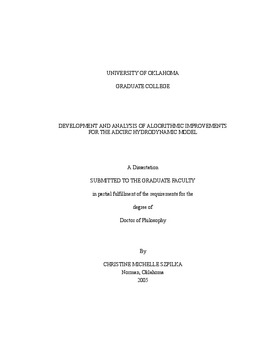| dc.contributor.advisor | Kolar, Randall L., | en_US |
| dc.contributor.author | Szpilka, Christine Michelle. | en_US |
| dc.date.accessioned | 2013-08-16T12:19:51Z | |
| dc.date.available | 2013-08-16T12:19:51Z | |
| dc.date.issued | 2005 | en_US |
| dc.identifier.uri | https://hdl.handle.net/11244/889 | |
| dc.description.abstract | This work addresses enhancements to the popular shallow water model, ADCIRC, ADvanced three-dimensional CIRCulation model. The shallow water equations (SWE) are based on conservation of mass and momentum and can be used to model the hydrodynamic behavior of oceans, coastal areas, estuaries and lakes. In this dissertation, four research areas have been identified in an effort to improve the predictive capabilities of ADCIRC: (1) Propagation analysis is a useful tool to examine the simulation characteristics of an algorithm. Two analytical tools exist for this analysis: Fourier and dispersion analysis. Unfortunately, it is not always possible to write an algorithm in the required closed form for these analyses. Therefore, a numerical analog of these tools was developed for this study. (2) Currently, the ADCIRC model suffers from local mass conservation errors is regions of high advection. Meanwhile, the discontinuous Galerkin (DG) finite element method is relatively new to the SWE modeling effort and has several appealing properties including: local mass conservation, shock capturing without spurious oscillations, and local h- and p- refinement. The numerical tools that were developed in topic 1 were used to compare the propagation behavior of the DG algorithm with the ADCIRC model. Results indicate that the DG algorithm has similar propagation behavior to the ADCIRC model. (3) Multi-algorithmic models, which couple continuous and discontinuous algorithms in the solution of the SWE, were examined in the hope of balancing accuracy with computational costs. Three levels of coupling were examined: equation, subdomain, and combined coupling. Propagation results indicate that the low-order versions are over-dissipative in the physical wavelengths. Furthermore, the equation and combined coupled models allow trailing wiggles if the higher-order approximations are not limited. (4) In this study, the local DG (LDG) method is applied to the advective-diffusive transport equation and added to the ADCIRC model as a module. The LDG transport model was verified with an analytical solution for breakthrough curves, and was found to be stable and mass conservative from advection-dominated flows to diffusion-dominated flows. (Abstract shortened by UMI.) | en_US |
| dc.format.extent | xxv, 422 leaves : | en_US |
| dc.subject | Engineering, Civil. | en_US |
| dc.subject | Hydrodynamics Computer programs. | en_US |
| dc.subject | Wave equation. | en_US |
| dc.subject | Engineering, Marine and Ocean. | en_US |
| dc.title | Development and analysis of algorithmic improvements for the ADCIRC hydrodynamic model. | en_US |
| dc.type | Thesis | en_US |
| dc.thesis.degree | Ph.D. | en_US |
| dc.thesis.degreeDiscipline | School of Civil Engineering and Environmental Science | en_US |
| dc.note | Source: Dissertation Abstracts International, Volume: 66-05, Section: B, page: 2723. | en_US |
| dc.note | Adviser: Randall L. Kolar. | en_US |
| ou.identifier | (UMI)AAI3174277 | en_US |
| ou.group | College of Engineering::School of Civil Engineering and Environmental Science | |
